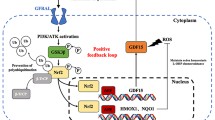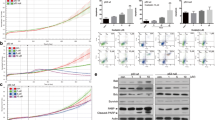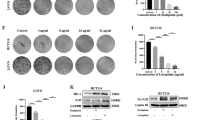Abstract
Altered expression of cellular redox genes and proteins contributes to invasion, metastasis, and drug resistance in cancer. NADPH oxidase (NOX) isoforms are the pro-oxidant enzymes that generate ROS as a primary product. Dysregulation of NOX activity and expression alters ROS generation, which either directly or indirectly modulates cell death and survival signaling during the progression of cancer. Nuclear factor erythroid 2-related factor 2 (Nrf-2) is an inducible transcription factor, which transcribes an array of antioxidant genes and protects cancer cells from the oxidative stress. Both NOXs and Nrf-2 participate in the regulation of cellular redox homeostasis; but their dysregulation promotes oxidative stress, which contributes to the progression of different types of cancer. Indeed, the role of NOX isoforms and Nrf-2 in developing the drug resistance in cancer is largely unknown. In the present study, we have explored the association of NOX isoforms and Nrf-2 signaling with the MDR1 gene expression in colon carcinoma cells (HCT-116/R). The MDR1 gene was overexpressed to develop resistant HCT-116/R cells and the NOX activation and ROS generation were monitored. We also assessed the role of NOX isoforms and Nrf-2 in the 5-fluorouracil (5-FU) mediated apoptotic cell death of HCT-116/R cells. The HCT-116/R cells demonstrated higher expression of HIF-1α, Nrf-2, and HO-1 and were highly resistant to 5-FU; they also displayed upregulated expression and activity of NOX-2, as well as elevated ROS levels. Interestingly, the treatment with HDC, a specific NOX-2 inhibitor, reduced the ROS levels in HCT-116/R cells. The treatment with HDC and ML-385 (specific inhibitor of Nrf-2) augmented the 5-FU-mediated apoptotic cell death of HCT-116/R cells, which suggests that NOX-2 and Nrf-2 are involved in the development of the chemoresistant phenotype of these cells. Taken together, NOX-2 and Nrf-2 are associated with developing drug resistance of colorectal cancer cells and might be potential targets to overcome drug resistance during cancer therapy.








Similar content being viewed by others
Abbreviations
- 5-FU:
-
5-fluorouracil
- ABC:
-
ATP-binding cassette
- DPBS:
-
Dulbecco’s phosphate buffered saline
- HCT-116/R:
-
MDR resistant colon cancer cells
- NOX:
-
NADPH oxidase
- Nrf-2:
-
nuclear factor erythroid 2-related factor 2
- ROS:
-
reactive oxygen species
References
Rawla, P., Sunkara, T., and Barsouk, A. (2019) Epidemiology of colorectal cancer: Incidence, mortality, survival, and risk factors, Prz. Gastroenterol., 14, 89.
Beheshti, M. (2018) Different strategies to overcome multidrug resistance in cancer. Research review, Int. Pharm. Acta, 1, 88-89.
Longley, D., and Johnston, P. (2005) Molecular mechanisms of drug resistance, J. Pathol., 205, 275-292.
Tanguturi, P., Kim, K.-S., and Ramakrishna, S. (2020) The role of deubiquitinating enzymes in cancer drug resistance, Cancer Chemother. Pharmacol., 85, 627-639.
Mansoori, B., Mohammadi, A., Davudian, S., Shirjang, S., and Baradaran, B. (2017) The different mechanisms of cancer drug resistance: a brief review, Adv. Pharm. Bull., 7, 339.
Choi, Y. H., and Yu, A. M. (2014) ABC transporters in multidrug resistance and pharmacokinetics, and strategies for drug development, Curr. Pharm. Des., 20, 793-807.
Locher, K. P., and Borths, E. (2004) ABC transporter architecture and mechanism: implications from the crystal structures of BtuCD and BtuF, FEBS Lett., 564, 264-268.
Holland, I. B. (2011) ABC transporters, mechanisms and biology: an overview, Essays Biochem., 50, 1-17.
Gottesman, M. M., and Pastan, I. H. (2015) The role of multidrug resistance efflux pumps in cancer: revisiting a JNCI publication exploring expression of the MDR1 (P-glycoprotein) gene, J. Natl. Cancer Inst., 107, djv222, https://doi.org/10.1093/jnci/djv222.
Gottesman, M. M., Fojo, T., and Bates, S. E. (2002) Multidrug resistance in cancer: role of ATP-dependent transporters, Nat. Rev. Cancer, 2, 48-58.
Snezhkina, A. V., Kudryavtseva, A. V., Kardymon, O. L., Savvateeva, M. V., Melnikova, N. V., et al. (2019) ROS generation and antioxidant defense systems in normal and malignant cells, Oxid. Med. Cell. Longev., 2019, 6175804, https://doi.org/10.1155/2019/6175804.
Maryanovich, M., and Gross, A. (2013) A ROS rheostat for cell fate regulation, Trends Cell Biol., 23, 129-134.
Schieber, M., and Chandel, N. S. (2014) ROS function in redox signaling and oxidative stress, Curr. Biol., 24, R453-R462.
Crane, F., and Low, H. (2008) Reactive oxygen species generation at the plasma membrane for antibody control, Autoimmun. Rev., 7, 518-522.
Krause, K.-H. (2004) Tissue distribution and putative physiological function of NOX family NADPH oxidases, Jpn. J. Infect. Dis., 57, S28-S29.
Weyemi, U., Redon, C. E., Parekh, P. R., Dupuy, C., and Bonner, W. M. (2013) NADPH oxidases NOXs and DUOXs as putative targets for cancer therapy, Anticancer Agents Med. Chem., 13, 502-514.
Juhasz, A., Markel, S., Gaur, S., Liu, H., Lu, J., et al. (2017) NADPH oxidase 1 supports proliferation of colon cancer cells by modulating reactive oxygen species-dependent signal transduction, J. Biol. Chem., 292, 7866-7887.
Banskota, S., Regmi, S. C., and Kim, J.-A. (2015) NOX1 to NOX2 switch deactivates AMPK and induces invasive phenotype in colon cancer cells through overexpression of MMP-7, Mol. Cancer, 14, 123.
Jaramillo, M. C., and Zhang, D. D. (2013) The emerging role of the Nrf2–Keap1 signaling pathway in cancer, Genes Dev., 27, 2179-2191.
Kessel, D., Beck, W. T., Kukuruga, D., and Schulz, V. (1991) Characterization of multidrug resistance by fluorescent dyes, Cancer Res., 51, 4665-4670.
Shen, F., Chu, S., Bence, A. K., Bailey, B., Xue, X., et al. (2008) Quantitation of doxorubicin uptake, efflux, and modulation of multidrug resistance (MDR) in MDR human cancer cells, J. Pharmacol. Exp. Ther., 324, 95-102.
Serrander, L., Cartier, L., Bedard, K., Banfi, B., Lardy, B., et al. (2007) NOX4 activity is determined by mRNA levels and reveals a unique pattern of ROS generation, Biochem. J., 406, 105-114.
Waghela, B. N., Sharma, A., Dhumale, S., Pandey, S. M., and Pathak, C. (2015) Curcumin conjugated with PLGA potentiates sustainability, anti-proliferative activity and apoptosis in human colon carcinoma cells, PLoS One, 10, e0117526.
Vaidya, F. U., Sharma, R., Shaikh, S., Ray, D., Aswal, V. K., and Pathak, C. (2019) Pluronic micelles encapsulated curcumin manifests apoptotic cell death and inhibits pro-inflammatory cytokines in human breast adenocarcinoma cells, Cancer Rep., 2, e1133.
Tonelli, C., Chio, I. I. C., and Tuveson, D. A. (2018) Transcriptional regulation by Nrf2, Antioxid. Redox Signal., 29, 1727-1745.
Furfaro, A., Traverso, N., Domenicotti, C., Piras, S., Moretta, L., et al. (2016) The Nrf2/HO-1 axis in cancer cell growth and chemoresistance, Oxid. Med. Cell. Longev., 2016, 1958174, https://doi.org/10.1155/2016/1958174.
Aggarwal, V., Tuli, H. S., Varol, A., Thakral, F., Yerer, M. B., et al. (2019) Role of reactive oxygen species in cancer progression: Molecular mechanisms and recent advancements, Biomolecules, 9, 735.
Wang, X., Son, Y.-O., Chang, Q., Sun, L., Hitron, J. A., et al. (2011) NADPH oxidase activation is required in reactive oxygen species generation and cell transformation induced by hexavalent chromium, Toxicol. Sci., 123, 399-410.
Das, D., Preet, R., Mohapatra, P., Satapathy, S. R., Siddharth, S., et al. (2014) 5-Fluorouracil mediated anti-cancer activity in colon cancer cells is through the induction of Adenomatous Polyposis Coli: implication of the long-patch base excision repair pathway, DNA Rep., 24, 15-25.
Grem, J. L. (2000) 5-Fluorouracil: forty-plus and still ticking. A review of its preclinical and clinical development, Invest. New Drugs, 18, 299-313.
Zhang, N., Yin, Y., Xu, S.-J., and Chen, W.-S. (2008) 5-Fluorouracil: mechanisms of resistance and reversal strategies, Molecules, 13, 1551-1569.
Pardini, B., Kumar, R., Naccarati, A., Novotny, J., Prasad, R. B., Forsti, A., et al. (2011) 5-Fluorouracil-based chemotherapy for colorectal cancer and MTHFR/MTRR genotypes, Br. J. Clin. Pharmacol., 72, 162.
Kovalev, A. A., Tsvetaeva, D. A., and Grudinskaja, T. V. (2013) Role of ABC-cassette transporters (MDR1, MRP1, BCRP) in the development of primary and acquired multiple drug resistance in patients with early and metastatic breast cancer, Exp. Oncol., 35, 287-290.
Van der Jeught, K., Xu, H.-C., Li, Y.-J., Lu, X.-B., and Ji, G. (2018) Drug resistance and new therapies in colorectal cancer, World J. Gastroenterol., 24, 3834.
Liu, Y., Li, Q., Zhou, L., Xie, N., Nice, E. C., et al. (2016) Cancer drug resistance: redox resetting renders a way, Oncotarget, 7, 42740.
Kamata, T. (2009) Roles of Nox1 and other Nox isoforms in cancer development, Cancer Sci., 100, 1382-1388.
Adachi, Y., Shibai, Y., Mitsushita, J., Shang, W., Hirose, K., and Kamata, T. (2008) Oncogenic Ras upregulates NADPH oxidase 1 gene expression through MEK-ERK-dependent phosphorylation of GATA-6, Oncogene, 27, 4921-4932.
Martner, A., Aydin, E., and Hellstrand, K. (2019) NOX2 in autoimmunity, tumor growth and metastasis, J. Pathol., 247, 151-154.
Taguchi, K., Motohashi, H., and Yamamoto, M. (2011) Molecular mechanisms of the Keap1–Nrf2 pathway in stress response and cancer evolution, Genes Cells, 16, 123-140.
Shibata, T., Kokubu, A., Gotoh, M., Ojima, H., Ohta, T., et al. (2008) Genetic alteration of Keap1 confers constitutive Nrf2 activation and resistance to chemotherapy in gallbladder cancer, Gastroenterology, 135, 1358-1368.e1354.
Sekhar, K. R., Crooks, P. A., Sonar, V. N., Friedman, D. B., Chan, J. Y., et al. (2003) NADPH oxidase activity is essential for Keap1/Nrf2-mediated induction of GCLC in response to 2-indol-3-yl-methylenequinuclidin-3-ols, Cancer Res., 63, 5636-5645.
Wu, R. F., and Terada, L. S. (2009) Ras and Nox: linked signaling networks? Free Radic. Biol. Med., 47, 1276-1281.
Laurent, E., McCoy, J. W. 3rd, Macina, R. A., Liu, W., Cheng, G., et al. (2008) Nox1 is over-expressed in human colon cancers and correlates with activating mutations in K-Ras, Int. J. Cancer, 123, 100-107.
Tao, S., Wang, S., Moghaddam, S. J., Ooi, A., Chapman, E., et al. (2014) Oncogenic KRAS confers chemoresistance by upregulating NRF2, Cancer Res., 74, 7430-7441.
Kovac, S., Angelova, P. R., Holmström, K. M., Zhang, Y., Dinkova-Kostova, A. T., and Abramov, A. Y. (2015) Nrf2 regulates ROS production by mitochondria and NADPH oxidase, Biochim. Biophys. Acta, 1850, 794-801.
Han, M., Zhang, T., Yang, L., Wang, Z., Ruan, J., and Chang, X. (2016) Association between NADPH oxidase (NOX) and lung cancer: a systematic review and meta-analysis, J. Thorac. Dis., 8, 1704.
Parekh, A., Das, S., Parida, S., Das, C. K., Dutta, D., et al. (2018) Multi-nucleated cells use ROS to induce breast cancer chemo-resistance in vitro and in vivo, Oncogene, 37, 4546-4561.
Longley, D. B., Harkin, D. P., and Johnston, P. G. (2003) 5-Fluorouracil: mechanisms of action and clinical strategies, Nat. Rev. Cancer, 3, 330-338.
He, L., Zhu, H., Zhou, S., Wu, T., Wu, H., et al. (2018) Wnt pathway is involved in 5-FU drug resistance of colorectal cancer cells, Exp. Mol. Med., 50, 1-12.
Kim, E.-K., Jang, M., Song, M.-J., Kim, D., Kim, Y., and Jang, H. H. (2019) Redox-mediated mechanism of chemoresistance in cancer cells, Antioxidants, 8, 471.
Kang, K., Piao, M., Kim, K., Kang, H., Chang, W., et al. (2014) Epigenetic modification of Nrf2 in 5-fluorouracil-resistant colon cancer cells: involvement of TET-dependent DNA demethylation, Cell Death Dis., 5, e1183-e1183.
Acknowledgements
The authors are grateful to the Indian Institute of Advanced Research, for providing the infrastructure and the research facility.
Funding
This study was supported by the SERB, Department of Science & Technology, New Delhi, Government of India (research grant EMR/2016/002574 to C. P.); ICMR, Gov of India (Senior Research fellowship to F. U. V.) and DST-INSPIRE (fellowship to B. N. W.).
Author information
Authors and Affiliations
Corresponding author
Ethics declarations
The authors declare no conflict of interest. This article does not contain description of studies with the involvement of humans or animal subjects.
Rights and permissions
About this article
Cite this article
Waghela, B.N., Vaidya, F.U. & Pathak, C. Upregulation of NOX-2 and Nrf-2 Promotes 5-Fluorouracil Resistance of Human Colon Carcinoma (HCT-116) Cells. Biochemistry Moscow 86, 262–274 (2021). https://doi.org/10.1134/S0006297921030044
Received:
Revised:
Accepted:
Published:
Issue Date:
DOI: https://doi.org/10.1134/S0006297921030044




